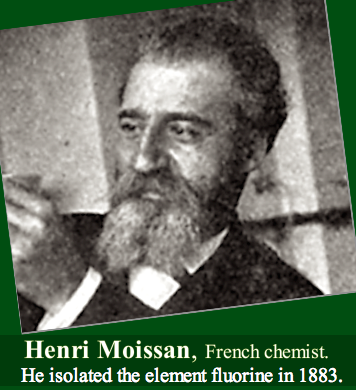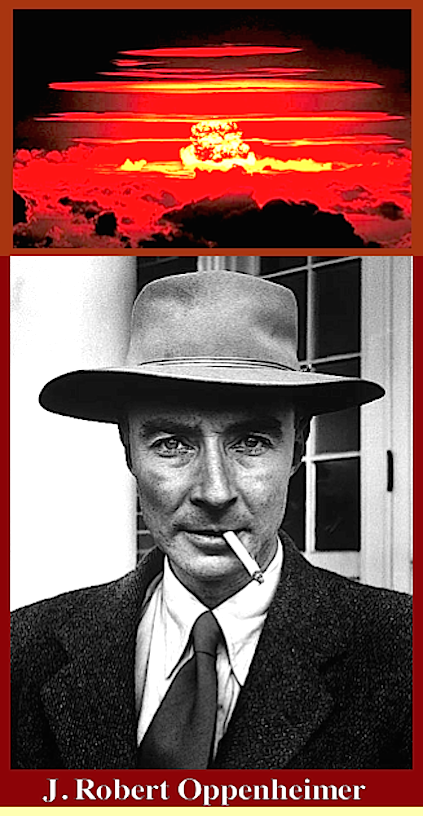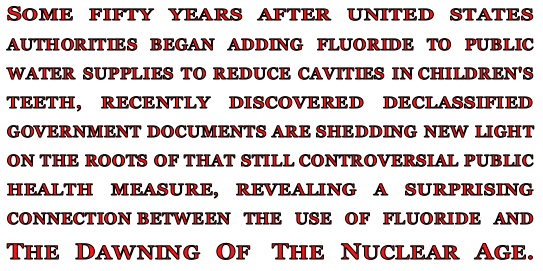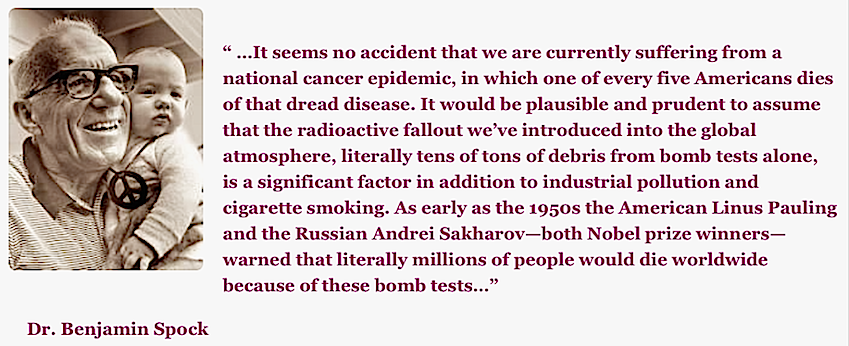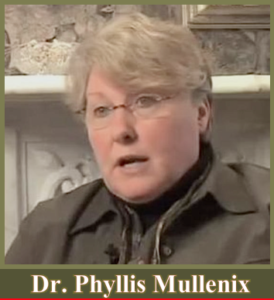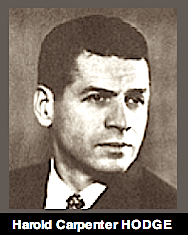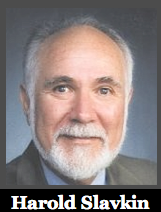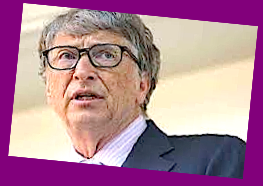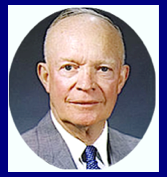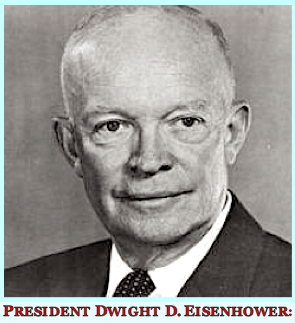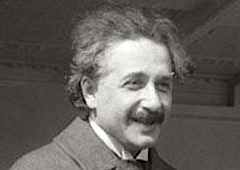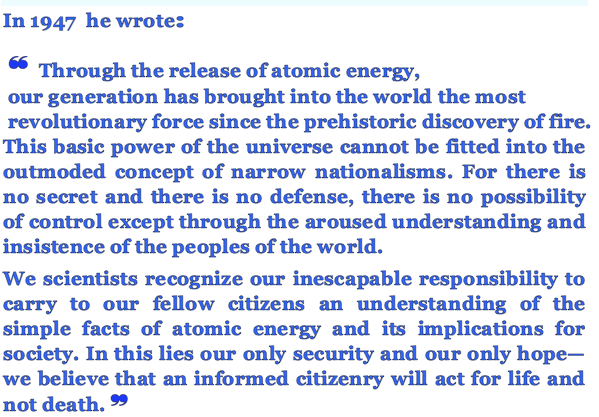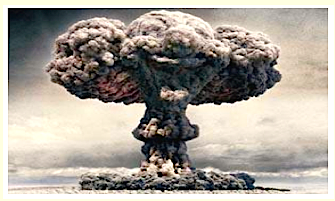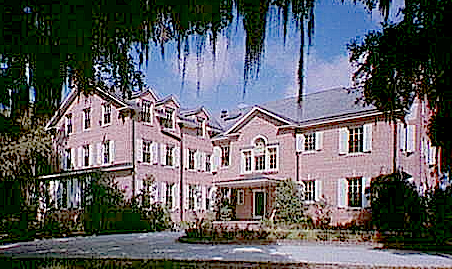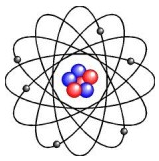THE SECRET HISTORY OF THE ATOMIC BOMB AND THE FLUORIDE CONNECTION.
August 8, 2014
Whale – by Eustace C. Mullins, June 1998
The world was stunned to learn that India has now tested nuclear weapons.
♦ For many years, all nations have been concerned about the proliferation of atomic explosives. Even in their distress, no one seems to be interested in the historic or the psychological record of why these weapons were developed, and what special breed of mankind devoted themselves to this diabolical goal.
Despite the lack of public interest, the record is clear, and easily available to anyone who is interested. My interest in this subject, dormant for many years was suddenly rekindled during my annual lecture tour in Japan. My hosts had taken me to the city of Nagasaki for the first time. Without telling me their plans, they entered the Nagasaki Atomic Bomb Museum. I thought it would be an interesting experience, but, to my surprise, when I walked into the exhibition rooms, I was suddenly overcome by sadness. Realizing that I was about to burst into tears, I moved away from my companions, and stood biting my lip. Even so, it seemed impossible to control myself. I was surrounded by the most gruesome objects, the fingers of a human hand fused with glass, a photograph of the shadow of a man on a brick wall; the man had been vaporized in the explosion .
A NEW MISSION
When I returned to the United States, I knew I had to unearth the sinister figures behind greatest of human catastrophes. It took many weeks of research to uncover what turned out to be the most far-reaching conspiracy of all time, the program of a few dedicated revolutionaries to seize control of the entire world, by inventing the powerful weapon ever unveiled.
The story begins in Germany. In the 1930s, Germany and Japan had a number of scientists icing on the development of nuclear fission. In both of these countries, their leaders sternly forbade them to continue their research. Adolf Hitler said he would never allow anyone in Germany to work on such an inhumane weapon.
The Emperor of Japan let his scientists know that he would never approve such a weapon. At that time the United States had no one working on nuclear fission. The disgruntled German scientists contacted friends in the United States, and were told that there was a possibility of government support for their work here. As Don Beyer tells these immigrants to the United States pushed their program.
“Leo Szilard, together with his long time friends and fellow Hungarian physicists, Eugene Wigner and Edward Teller, agreed that the President must be warned; fission bomb tehnology was not so farfetched. The Jewishemigres, now living in America, had personal experience of fascism in Europe. In 1939, the three physicists enlisted the support of Albert Einstein, letter dated 2nd August signed by Einstein was delivered by Alexander Sachs to Franklin D. Roosevelt at the White House on 11 October 39.”
CRIMINALS ON DISPLAY
At the Nagasaki Atomic Bomb Museum, photographs of two men are prominently displayed; Albert Einstein, and J. Robert Oppenheimer, who developed the atomic bomb at Los Alamos laboratories, New Mexico. Also on display is a statement from General Eisenhower, who was then supreme Military Commander, which is found in number of books about Eisenhower, and which can be found on p.426, Eisenhower by Stephen E.Ambrose, Simon & Shuster, NY, 1983.
“Secretary of War Henry L. Stimson first told Eisenhower of the bomb’s existence. Eisenhower was engulfed by “a feeling of depression’. When Stimson said the United States proposed to use the bomb against Japan, Eisenhower voiced ‘my grave misgivings, first on the basis of my belief that Japan was already defeated and that dropping the bomb was completely unnecessary, and secondly because I thought that our country should avoid shocking world opinion by the use (of atomic weapons).’ Stimson was upset by Eisenhower’s attitude ‘almost angrily refuting the reasons I gave for my quick conclusion’. Three days later, Eisenhower flew to Berlin, where he met with Truman and his principal advisors.
Again Eisenhower recommended against using the bomb, and again [he] was ignored.
Other books on Eisenhower state that he endangered his career by his protests against the bomb, which the conspirators in the highest level of the United States government had already sworn to use against Japan, regardless of any military developments. Eisenhower could not have known that Stimson was a prominent member of Skull and Bones at Yale, the Brotherhood of Death, founded by the Russell Trust in 1848 as a bunch of the German Illuminati, or that they had played prominent roles in organizing wars and revolutions since that time. Nor could he have known that President Truman had only had one job in his career, as a Masonic organizer for the State of Missouri, and that the lodges he built up later sent him to the United States Senate and then to the presidency.
ATOMIC TERRORISM
The man who set all this in motion was Albert Einstein, who left Europe and came to the United States in October 1933. His wife said that he “regarded human beings with detestation.” He had previously corresponded with Sigmund Freud about his projects of “peace” and “disarmament”, although Freud later said he did not believe that Einstein ever accepted any of his theories. Einstein had a personal interest in Freud’s work because his son Eduard spent his life in mental institutions, undergoing both insulin therapy and electroshock treatment, none of which produced any change in his condition.
When Einstien arrived in the United States, he was feted as a famous scientist, and was invited to the White House by President and Mrs. Roosevelt. He was soon deeply involved with Eleanor Roosevelt in her many leftwing causes, in which Einstein heartily concurred. Some of Einstein’s biographers hail the modern era as “the Einstein Revolution” and “the Age of Einstein”, possibly because he set in motion the program of nuclear fission in the United States. His letter to Roosevelt requesting that the government inaugurate an atomic bomb program was obviously stirred by his lifelong commitment to “peace and disarmament”. His actual commitment was to Zionism; Ronald W. Clark mentions in Einstein; His Life And Times, Avon, 1971, p.377, “He would campaign with the Zionists for a Jewish homeland in Palestine.” On p.460, Clark quotes Einstein, “As a Jew I am from today a supporter of the Jewish Zionist efforts.” (1919) Einstein’s letter to Roosevelt, dated august 2, 1939, was delivered personally to President Roosevelt by Alexander Sachs on October 11. Why did Einstein enlist an intermediary to bring this letter to Roosevelt, with whom he was on friendly terms? The atomic bomb program could not be launched without the necessary Wall Street sponsorship. Sachs, a Russian Jew, listed his profession as “economist” but was actually a bagman for the Rothschilds, who regularly delivered large sums of cash to Roosevelt in the White House. Sachs was an advisor to Eugene Meyer of the Lazard Freres International Banking House, and also with Lehman Brothers, another well known banker. Sachs’ delivery of the Einstein letter to the White House let Roosevelt know that the Rothschilds approved of the project and wished him to go full speed ahead.
A UNITED NATIONS PROJECT
In May of 1945, the architects of postwar strategy, or, as they liked to call themselves, the “Masters of the Universe”, gathered in San Francisco at the plush Palace Hotel to write the Charter for the United Nations. Several of the principals retired for a private meeting in the exclusive Garden Room. The head of the United States delegation had called this secret meeting with his top aide, Alger Hiss, representing the president of the United States and the Soviet KGB; John Foster Dulles, of the Wall Street law firm of Sullivan and Cromwell, whose mentor, William Nelson Cromwell, had been called a “professional revolutionary” on the floor of Congress; and W. Averill Harriman, plenipotentiary extraordinary, who had spent the last two years in Moscow directing Stalin’s war for survival. These four men represented the awesome power of the American Republic in world affairs, yet of the four, only Secretary of State Edward Stettinius Jr., had a position authorized by the Constitution. Stettinius called the meeting to order to discuss an urgent matter; the Japanese were already privately suing for peace, which presented a grave crisis. The atomic bomb would not be ready for several more months. “We have already lost Germany,” Stettinius said. “If Japan bows out, we will not have a live population on which to test the bomb.”
“But, Mr. Secretary,” said Alger Hiss, “no one can ignore the terrible power of this weapon.” “Nevertheless,” said Stettinius, “our entire postwar program depends on terrifying the world with the atomic bomb.” “To accomplish that goal,” said John Foster Dulles, “you will need a very good tally. I should say a million.” “Yes,” replied Stettinius, “we are hoping for a million tally in Japan. But if they surrender, we won’t have anything.” “Then you have to keep them in the war until the bomb is ready,” said John Foster Dulles. “That is no problem. Unconditional surrender.” “They won’t agree to that,” said Stettinius. “They are sworn to protect the Emperor.” “Exactly,” said John Foster Dulles. “Keep Japan in the war another three months, and we can use the bomb on their cities; we will end this war with the naked fear of all the peoples of the world, who will then bow to our will.”
Edward Stettinius Jr. was the son of a J.P. Morgan partner who had been the world’s largest munitions dealer in the First World War. He had been named by J.P. Morgan to oversee all purchases of munitions by both France and England in the United States throughout the war. John Foster Dulles was also an accomplished warmonger. In 1933, he and his brother Allen had rushed to Cologne to meet with Adolf Hitler and guaranteed him the funds to maintain the Nazi regime. The Dulles brothers were representing their clients, Kuhn Loeb Co., and the Rothschilds. Alger Hiss was the golden prince of the communist elite in the united States. When he was chosen as head of the prestigious Carnegie Endowment for International Peace after World War II, his nomination was seconded by John Foster Dulles. Hiss was later sent to prison for perjury for lying about his exploits as a Soviet espionage agent.
This secret meeting in the Garden Room was actually the first military strategy session of the United Nations, because it was dedicated to its mission of exploding the world’s first atomic weapon on a living population. It also forecast the entire strategy of the Cold War, which lasted forty-three years, cost American taxpayers five trillion dollars, and accomplished exactly nothing, as it was intended to do. Thus we see that the New World Order has based its entire strategy on the agony of the hundreds of thousands of civilians burned alive at Hiroshima and Nagasaki, including many thousands of children sitting in their schoolrooms. These leaders had learned from their master, Josef Stalin, that no one can rule without mass terrorism, which in turn required mass murder. As Senator Vandenberg, leader of the Republican loyal opposition, was to say (as quoted in American Heritage magazine, August 1977), “We have got to scare the hell out of “em.”
THE JEWISH HELL-BOMB
The atomic bomb was developed at the Los Alamos Laboratories in New Mexico. The top secret project was called the Manhattan Project, because its secret director, Bernard Baruch, lived in Manhattan, as did many of the other principals. Baruch had chosen Maj. Gen. Leslie R. Groves to head the operation. He had previously built the Pentagon, and had a good reputation among the Washington politicians, who usually came when Baruch beckoned.
The scientific director at Los Alamos was J. Robert Oppenheimer, scion of a prosperous family of clothing merchants. In Oppenheimer; The Years Of Risk, by James Kunetka, Prentice Hall, NY, 1982, Kunetka writes, p. 106, “Baruch was especially interested in Oppenheimer for the position of senior scientific adviser.” The project cost an estimated two billion dollars. No other nation in the world could have afforded to develop such a bomb. The first successful test of the atomic bomb occurred at the Trinity site, two hundred miles south of Los Alamos at 5:29:45 a.m. on July 16, 1945. Oppenheimer was beside himself at the spectacle. He shrieked, “I am become Death, the Destroyer of worlds.” Indeed, this seemed to be the ultimate goal of the Manhattan Project, to destroy the world. There had been considerable fear among the scientists that the test explosion might indeed set off a chain reaction, which would destroy the entire world. Oppenheimer’s exultation came from his realization that now his people had attained the ultimate power, through which they could implement their five-thousand-year desire to rule the entire world.
THE BUCK PASSES TO TRUMAN
Although Truman liked to take full credit for the decision to drop the atomic bomb on Japan, in fact, he was advised by a prestigious group, The National Defense Research Committee, consisting of George L. Harrison, president of the Federal Reserve Bank of New York; Dr. James B. Conant, president of Harvard, who had spent the First World War developing more effective poison gases, and who in 1942 had been commissioned by Winston Churchill to develop an Anthrax bomb to be used on Germany, which would have killed every living thing in Germany. Conant was unable to perfect the bomb before Germany surrendered, otherwise he would have had another line to add to his resume. His service on Truman’s Committee which advised him to drop the atomic bomb on Japan, added to his previous record as a chemical warfare professional, allowed me to describe him in papers filed before the United States Court of Claims in 1957, as “the most notorious war criminal of the Second World War”. As Gauleiter of Germany after the war, he had ordered the burning of my book, The Federal Reserve Conspiracy, ten thousand copies having been published in Oberammergau, the site of the world-famed Passion Play.
Also on the committee were Dr. Karl Compton, and James F. Byrnes, acting Secretary of State. For thirty years, Byrnes had been known as Bernard Baruch’s man in Washington. With his Wall Street profits, Baruch had built the most lavish estate in South Carolina, which he named Hobcaw Barony. As the wealthiest man in South Carolina, this epitome of the carpet-bagger also controlled the political purse strings. Now Baruch was in a position to dictate to Truman, through his man Byrnes, that he should drop the atomic bomb on Japan.
LIPMAN SIEW
Despite the fact that the Manhattan Project was the most closely guarded secret of World War II, one man, and one many only, was allowed to observe everything and to know everything about the project. He was Lipman Siew, a Lithuanian Jew who had come to the United States as a political refugee at the age of seventeen. He lived in Boston on Lawrence St., and decided to take the name of William L. Laurence. At Harvard, he became a close friend of James B. Conant and was tutored by him. When Laurence went to New York, he was hired by Herbert Bayard Swope, editor of the New York World, who was known as Bernard Baruch’s personal publicity agent. Baruch owned the World. In 1930, Laurence accepted an offer from the New York Times to become its science editor. He states in Who’s Who that he “was selected by the heads of the atomic bomb project as sole writer and public relations.” How one could be a public relations writer for a top secret project was not explained. Laurence was the only civilian present at the historic explosion of the test bomb on July 16, 1945. Less than a month later, he sat in the copilots seat of the B-29 on the fateful Nagasaki bombing run.
WILL JAPAN SURRENDER BEFORE THE BOMB IS DROPPED?
There were still many anxious moments for the conspirators, who planned to launch a new reign of terror throughout the world. Japan had been suing for peace. Each day it seemed less likely that she could stay in the war. On March 9 and 10, 1945, 325 B-29s had burned thirty-five square miles of Tokyo, leaving more than one hundred thousand Japanese dead in the ensuing firestorm. Of Japan’s 66 biggest cities, 59 had been mostly destroyed. 178 square miles of urban dwellings had been burned, 500,000 died in the fires, and now twenty million Japanese were homeless. Only four cities had not been destroyed; Hiroshima, Kokura, Niigata, and Nagasaki.
Their inhabitants had no inkling that they had been saved as target cities for the experimental atomic bomb. Maj. Gen. Leslie Groves, at Bernard Baruch’s insistence, had demanded that Kyoto be the initial target of the bomb. Secretary of War Stimson objected, saying that as the ancient capital of Japan, the city of Kyoto had hundreds of historic wooden temples, and no military targets. The Jews wanted to destroy it precisely because of its great cultural importance to the Japanese people.
THE HORROR OF HIROSHIMA
While the residents of Hiroshima continued to watch the B-29s fly overhead without dropping bombs on them, they had no inkling of the terrible fate which the scientists had reserved for them. William Manchester quotes General Douglas MacArtbur in American Caesar, Little Brown, 1978, p.437
[quoting:] There was another Japan, and MacArthur was one of the few Americans who suspected its existence. He kept urging the Pentagon and the State Department to be alert for conciliatory gestures. The General predicted that the break would come from Tokyo, not the Japanese army. The General was right. A dovish coalition was forming in the Japanese capital, and it was headed by Hirohito himself, who had concluded in the spring of 1945 that a negotiated peace was the only way to end his nation’s agony. Beginning in early May, a six-man council of Japanese diplomats explored ways to accommodate the Allies. The delegates informed top military officials that “our resistance is finished”. [End quoting]
On p.359, Gar Alperowitz quotes Brig. Gen. Carter W. Clarke, in charge of preparing the MAGIC summary in 1945, who stated in a 1959 historical interview, “We brought them down to an abject surrender through the accelerated sinking of their merchant marine and hunger alone, and when we didn’t need to do it, and knew we didn’t need to do it, we used them as an experiment for two atomic bombs.”
Although President Truman referred to himself as the sole authority in the decision to drop the bomb, in fact he was totally influenced by Bernard Baruch’s man in Washington, James F. Byrnes. Gar Alperowitz states, p. 196, “Byrnes spoke with the authority of—personally represented—the president of the United States on all bomb-related matters in the Interim Committee’s deliberations.” David McCullough, in his laudatory biography of Truman, which was described as “a valentine”, admitted that “Truman didn’t know his own Secretary of State, Stettinius. He had no background in foreign policy, no expert advisors of his own.”
The tragedy of Hiroshima and Nagasaki was that a weak, inexperienced president, completely under the influence of Byrnes and Baruch, allowed himself to be manipulated into perpetrating a terrible massacre. In the introduction to Hiroshima’s Shadows, we find that “Truman was moving in quite the opposite direction, largely under the influence of Byrnes. The atom bomb for Byrnes was an instrument of diplomacy-atomic diplomacy.” (p.ix)
MASS MURDER
On August 6, 1945, a uranium bomb 3-235, 20 kilotons yield, was exploded 1850 feet in the air above Hiroshima, for maximum explosive effect. It devastated four square miles, and killed 140,000 of the 255,000 inhabitants. In Hiroshima’s Shadows, we find a statement by a doctor who treated some of the victims; p.415, Dr. Shuntaro Hida: “It was strange to us that Hiroshima had never been bombed, despite the fact that B-29 bombers flew over the city every day. Only after the war did I come to know that Hiroshima, according to American archives, had been kept untouched in order to preserve it as a target for the use of nuclear weapons. Perhaps, if the American administration and its military authorities had paid sufficient regard to the terrible nature of the fiery demon which mankind had discovered and yet knew so little about its consequences, the American authorities might never have used such a weapon against the 750,000 Japanese who ultimately became its victims.”
Dr. Hida says that while treating the terribly mangled and burned victims, “My eyes were ready to overflow with tears. I spoke to myself and bit my lip so that I would not cry. If I had cried, I would have lost my courage to keep standing and working, treating dying victims of Hiroshima.”
On p.433, Hiroshima’s Shadows, Kensaburo Oe declares, “From the instant the atomic bomb exploded, it became the symbol of all human evil; it was a savagely primitive demon and most modern curse…. My nightmare stems from a suspicion that a ‘certain trust in human strength’ or ‘humanism’ flashed across the minds of American intellectuals who decided upon the project that concluded with the dropping of the bomb on Hiroshima.”
In the introduction to Hiroshima’s Shadows, we find that “One of the myths of Hiroshima is that the inhabitants were warned by leaflets that an atomic bomb would be dropped. The leaflets Leonard Nadler and William P. Jones recall seeing in the Hiroshima Museum in 1960 and 1970 were dropped after the bombing. This happened because the President’s Interim Committee on the Atomic Bomb decided on May 31 ‘that we could not give the Japanese any warning’. Furthermore, the decision to drop ‘atomic’ leaflets on Japanese cities was not made until August 7, the day after the Hiroshima bombing. They were not dropped until August 10, after Nagasaki had been bombed. We can say that the residents of Hiroshima received no advance warning about the use of the atomic bomb. On June 1, 1945, a formal and official decision was taken during a meeting of the so-called Interim Committee not to warn the populations of the specific target cities. James Byrnes and Oppenheimer insisted that the bombs must be used without prior warning.”
“Closely linked to the question of whether a warning of an atomic bomb attack was given to the civilian populations of the target cities is the third ‘article of fifth’ that underpins the American legend of Hiroshima; the belief that Hiroshima and Nagasaki were military targets. The Headquarters of the Japanese Second army were located in Hiroshima and approximately 20,000 men—of which about half, or 10,000 died in the attack. In Nagasaki, there were about 150 deaths among military personnel in the city. Thus, between the two cities, 4.4% of the total death toll was made up of military personnel. In short, more than 95% of the casualties were civilians.”
On p.39 of Hiroshima’s Shadows we find that (at Hiroshima) “strictly military damage was insignificant.” How are we to reconcile this statement with Harry Truman’s vainglorious boast in Off The Record; the Private Papers of Harry S. Truman Harper, 1980, p.304, “In 1945 I had ordered the Atomic Bomb dropped on Japan at two places devoted almost exclusively to war production.” In fact, many thousands of the Hiroshima casualties were children sitting in their classrooms.
The bomb was dropped because (p.35) “The Manhattan Project’s managers were lobbying to use the atomic bomb. Byrnes sat in on these meetings. Maj. Gen. Groves seems to have been the author of the claim that the use of the bomb would save a million American lives—-a figure in the realm of fantasy.”
Truman himself variously stated that the use of the use of the atomic bomb saved “a quarter of a million American lives”, a “half-million American lives”, and finally settled on the Gen. Groves figure of “a million American lives saved.”
Meanwhile (p.64) William L. Laurence, who was writing for the New York Times at full salary while also receiving a full salary from the War Department as the “public relations agent for the atomic bomb” published several stories in the New York Times denying that there had been any radiation effects on the victims of the Hiroshima bombing (Sept. 5, 1945 et seq.) in which he quotes General Groves’ indignant comment, “The Japanese are still continuing their propaganda aimed at creating the impression we won the war unfairly and thus attempting to create sympathy for themselves.”
(p.66) “The Legation of Switzerland on August 11, 1945 forwarded from Tokyo the following memorandum to the State Department (which sat on it for twenty-five years before finally releasing it): ‘The Legation of Switzerland has received a communication from the Japanese Government.’ On August 6, 1945, American airplanes released on the residential district of the town of Hiroshima, bombs of a new type, killing and injuring in one second a large number of civilians and destroying a great part of the town. Not only is the city of Hiroshima a provincial town without any protection or special military installations of any kind, but also none of the neighboring regions or towns constitutes a military objective.”
The introduction to Hiroshima’s Shadows concludes that (p.lxvii) “The claim that an invasion of the Japanese home islands was necessary without the use of the atomic bombs is untrue. The claim that an ‘atomic warning’ was given to the populace of Hiroshima is untrue. And the claim that both cities were key military targets is untrue.”
A PILOT’S STORY
Corroboration of these statements is found in the remarkable record of Ellsworth Torrey Carrington, “Reflections of a Hiroshima Pilot”, (p.9) “As part of the Hiroshima atomic battle plan my B-29 (named Jabbitt III, Captain John Abbott Wilson’s third war plane) flew the weather observation mission over the secondary target of Kokura on August 6, 1945.” (p. 10) “After the first bomb was dropped, the atom bomb command was very fearful that Japan might surrender before we could drop the second bomb, so our people worked around the clock, 24-hours-a-day to avoid such a misfortune.” This is, of course, satire on Carrington’s part. (p. 13) “in city after city all over the face of Japan (except for our cities spared because reserved for atomic holocaust) they ignited the most terrible firestorms in history with very light losses (of B-29s). Sometimes the heat from these firestorms was so intense that later waves of B-29s were caught by updrafts strong enough to loft them upwards from 4 or 5,000 feet all the way up to 8 or 10,000 feet. The major told us that the fire-bombing of Japan had proven successful far beyond anything they had imagined possible and that the 20th Air Force was running out of cities to burn. Already there were no longer (as of the first week in June 1945) any target cities left that were worth the attention of more than 50 B-29s, and on a big day, we could send up as many as 450 planes!” “The totality of the devastation in Japan was extraordinary, and this was matched by the near-totality of Japan’s defencelessness.” (as of June 1, 1945, before the atomic bombs were dropped.) (p. 14) “The Truman government censored and controlled all the war information that was allowed to reach the public, and of course, Truman had a vested interest in obscuring the truth so as to surreptitiously prolong the war and be politically able to use the atom bomb. Regarding the second element of the Roosevelt-Truman atomic Cold War strategy of deceiving the public into believing that Japan was still militarily viable in the spring and summer of 1945, the centerpiece was the terribly expensive and criminally unnecessary campaign against Okinawa.
Carrington quotes Admiral William D. Leahy, p. 245, I Was There, McGraw Hill: “A large part of the Japanese Navy was already on the bottom of the sea. The combined Navy surface and air force action even by this time had forced Japan into a position that made her early surrender inevitable. None of us then knew the potentialities of the atomic bomb, but it was my opinion, and I urged it strongly on the Joint Chiefs, that no major land invasion of the Japanese mainland was necessary to win the war. The JCS did order the preparation of plans for an invasion, but the invasion itself was never authorized.”
Thus Truman, urged on by General Groves, claims that “a million American lives were saved” by the use of the atomic bomb, when no invasion had ever been authorized, and was not in the cards. Carrington continues, p. 16, “The monstrous truth is that the timing of the Okinawa campaign was exclusively related to the early August timetable of the atomic bomb. J’accuse! I accuse Presidents Franklin Roosevelt and Harry Truman of deliberately committing war crimes against the American people for the sole purpose of helping set the stage for the criminally unnecessary use of atomic weapons on Japan.”
Carrington further quotes Admiral Leahy, from I Was There, “It is my opinion that the use of this barbarous weapon at Hiroshima and Nagaski was of no material assistance in our war against Japan. The Japanese were already defeated and ready to surrender because of the effective sea blockade and the successful bombing with conventional weapons.”
Carrington concludes, p.22, “Truman’s wanton use of atomic weapons left the American people feeling dramatically less secure after winning World War II than they had ever felt before, and these feelings of insecurity have been exploited by unscrupulous Cold War Machine Politicians ever since.” As Senator Vandenberg said, “We have to scare the hell out of ‘em” in order to browbeat the American people into paying heavy taxes to support the Cold War.
DID THE ATOMIC BOMB WIN THE WAR AGAINST JAPAN?
Admiral William Leahy also stated in I Was There, “My own feeling is that being the first to use it (the atomic bomb) we had adopted an ethical standard common to the Barbarism of the Dark Ages. I was not taught to make war in that fashion, and wars cannot be won by destroying women and children.”
Gar Alperowitz notes, p. 16, “On May 5, May 12 and June 7, the Office of Strategic Services (our intelligence operation), reported Japan was considering capitulation. Further messages came on May 18, July 7, July 13 and July 16.”
Alperowitz points out, p.36, “The standing United States demand for ‘unconditional surrender’ directly threatened not only the person of the Emperor but such central tenets of Japanese culture as well.”
Alperowitz also quotes General Curtis LeMay, chief of the Air Forces, p.334, “The war would have been over in two weeks without the Russians entering and without the atomic bomb. PRESS INQUIRY: You mean that, sir? Without the Russians and without the atomic bomb? LeMay: The atomic bomb had nothing to do with the end of the war at all.” September 29, 1945, statement.
THE NAGASAKI BOMB
When the Air Force dropped the atomic bomb on Nagasaki, with William Laurence riding in the co-pilot’s seat of the B-29, pretending to be Dr. Strangelove, here again the principal target was a Catholic church. P.93, The Fall Of Japan, by William Craig, Dial, NY, 1967, “the roof and masonry of the Catholic cathedral fell on the kneeling worshippers. All of them died.” This church has now been rebuilt, and is a prominent feature of the Nagasaki tour.
After the terror bombings of Hiroshima and Nagasaki, the victorious Allies moved promptly to try Japanese officials for their “war crimes”. From 1945-51 several thousand Japanese military men were found guilty of war crimes by an International Military Tribunal which met in Tokyo from 1946 to 1948. Twenty-eight Japanese military and civilian leaders were accused of having engaged in conspiracy to commit atrocities. The dissenting member of the Tokyo tribunal, Judge Radhabinod of India, dismissed the charge that Japanese leaders had conspired to commit atrocities, stating that a stronger case might be made against the victors, because the decision to use the atomic bomb resulted in indiscriminate murder.
A very popular movie in Japan today is Pride, The Fateful Moment, which shows Prime Minister General Hideki Tojo in a favorable light. With six others, he was hanged in 1968 as a war criminal. During his trial, his lawyers stated to the International Tribunal for the Far East, the Asian version of Nuremberg Trials, that Tojo’s war crimes could not begin to approach the dropping of the atomic bombs on Hiroshima and Nagasaki. The prosecutors immediately objected, and censored their statements. That was the last time there was any official recognition of the atomic bomb massacres in Japan. Japanese officials have been effectively prevented from taking any stand on this matter because the American military occupation, which officially ended in 1952 with the Treaty with Japan, was quietly continued. Today, 49,000 American troops are still stationed in Japan, and there is no public discussion of the crimes of Hiroshima and Nagasaki.
AMERICAN MILITARY AUTHORITIES SAY ATOMIC BOMB UNNECESSARY
The most authoritative Air Force unit during World War II was the U.S. Strategic Bombing Survey, which selected targets on the basis of need, and which analyzed the results for future missions.
In Hiroshima’s Shadow, the U.S. Strategic Bombing Survey report of July 1, 1946 states, “The Hiroshima and Nagasaki atomic bombs did not defeat Japan, nor by the testimony of the enemy leaders who ended the war did they persuade Japan to accept unconditional surrender. The Emperor, the lord privy seal, the prime minister, the foreign minister, and the navy minister had decided as early as May 1945 that the war should be ended even if it meant acceptance of defeat on allied terms…. It is the Survey’s opinion that certainly prior to December 1, 1945 and in all probability prior to November 1, 1945, Japan would have surrendered even if the atomic bombs had not been dropped and even if no invasion had been planned or contemplated.”
Both military, political and religious leaders spoke out against the atomic bombing of Japanese civilians. The Federal Council of the Churches of Christ in America issued a formal statement in March 1946 (cited by Gar Alperowitz):
“The surprise bombings of Hiroshima and Nagasaki are morally indefensible. Both bombings must be judged to have been unnecessary for winning the war. As the power that first used the atomic bomb under thesecircumstances, we have sinned grievously against the laws of God and against the people of Japan.”—Commission on the Relation of the Church to the War in the Light of the Christian Faith.
On p.438, Gar Alperowitz quotes James M. Gillis, editor of Catholic World, “I would call it a crime were it not that the word ‘crime’ implies sin, and sin requires a consciousness of guilt. The action taken by the Untied States government was in defiance of every sentiment and every conviction upon which our civilization is based.”
One of the most vociferous critics of the atomic bombings was David Lawrence, founder and editor of U.S. News and World Report. He signed a number of stinging editorials, the first on August 17, 1945.
“Military necessity will be our constant cry in answer to criticism, but it will never erase from our minds the simple truth, that we, of all civilized nations, though hesitating to use poison gas, did not hesitate to employ the most destructive weapon of all times indiscriminately against men, women and children.” On October 5, Lawrence continued his attack, “The United States should be the first to condemn the atomic bomb and apologize for its use against Japan. Spokesmen for the Army Air Forces said it wasn’t necessary and that the war had been won already. Competent testimony exists to prove that Japan was seeking to surrender many weeks before the atomic bomb came.” On November 23, Lawrence wrote, “The truth is we are guilty. Our conscience as a nation must trouble us. We must confess our sin. We have used a horrible weapon to asphyxiate and cremate more than 100,000 men, women and children in a sort of super-lethal gas chamber— and all this in a war already won or which spokesman for our Air Forces tell us we could have readily won without the atomic bomb. We ought, therefore, to apologize in unequivocal terms at once to the whole world for our misuse of the atomic bomb.”
David Lawrence was an avowed conservative, a successful businessman, who knew eleven presidents of the United States intimately, and was awarded the Medal of Freedom by President Richard M. Nixon, April 22, 1970.
ANOTHER EISENHOWER SPEAKS
Although Eisenhower never changed his opinion of the use of the atomic bomb, during his presidency he repeatedly voiced his opinion, as quoted by Steve Neal, The Eisenhowers Doubleday, 1978. P.225, “Ike would never lose his scepticism of the weapon and later referred to it as a ‘hellish contrivance’.”
His brother, Milton Eisenhower, a prominent educator, was even more vocal on this subject. As quoted by Gar Alperwitz, p.358, Milton Eisenhower said, “Our employment of this new force at Hiroshima and Nagasaki was a supreme provocation to other nations, especially the Soviet Union. Moreover, its use violated the normal standards of warfare by wiping out entire populations, mostly civilians, in the target cities. Certainly what happened at Hiroshima and Nagasaki will forever be on the conscience of the American people.”
During his Presidency, Dwight Eisenhower tried to find peaceful uses for atomic energy. In The Eisenhower Diaries, p.261, we find that “The phrase ‘atoms for peace’ entered the lexicon of international affairs with a speech by Eisenhower before the United Nations December 8, 1953.” Control of atomic energy had now given the New World Order clique enormous power, and Eisenhower, in his farewell speech to the American people on leaving the Presidency In Review (Doubleday, 1969), on January 17, 1961, warned, “In the councils of government we must guard against the acquisition of unwarranted influence, whether sought or unsought, by the miliary-industrial complex. The potential for the disastrous rise of misplaced power exists and will persist.”
By failing to name the power behind the military-industrial complex, the international bankers, Eisenhower left the American people in the dark as to he was actually warning them against. To this day they do not understand what he was trying to say, that the international bankers, the Zionists and the Freemasons had formed an unholy alliance whose money and power could not be overcome by righteous citizens of the United States.
MACARTHUR’S WARNING
General Douglas MacArthur also tried to warn the American people of this threat, as quoted in American Ceaser, by William Manchester, Little Brown, 1978, p.692, “In 1957, he lashed out at large Pentagon budgets. ‘Our government has kept us in a perpetual state of fear—kept us in a continuous stampede of patriotic fervor—with the cry of grave national emergency. Always there has been some terrible evil to gobble us up if we did not blindly rally behind it by furnishing the exorbitant funds demanded. Yet, in retrospect, these disasters seem never to have happened, seem never to have been quite real.”
This was the restatement of Senator Vandenberg’s famous comment, “We have to scare the hell out of ‘em.”
THE NEW ATOMIC AGE
The scientists who had built the atomic bomb were gleeful when they received the news of its success at Hiroshima and Nagasaki. In the book, Robert Oppenheimer, Dark Prince, by Jack Rummel, 1992, we find, p.96, “Back in the United States the news of the bombing of Hiroshima was greeted with a mixture of relief, pride, joy, shock and sadness. Otto Frisch remembers the shouts of joy, ‘Hiroshima has been destroyed!’ ‘Many of my friends were rushing to the telephone to book tables at the La Fonda Hotel in Santa Fe in order to celebrate. Oppenheimer walked around “like a prizefighter, clasping his hands together above his head as he came to the podium”.’”
Oppenheimer had been a lifelong Communist. “He was heavily influenced by Soviet Communism “: A New Civilization, by Sidney and Beatrice Webb, the founders of Fabian Socialism in England. He became director of research at the newly formed U.S. Atomic Energy Commission, with his mentor, Bernard Baruch, serving as chairman. Oppenheimer continued his many Communist Party Associations; his wife was Kitty Peuning, widow of Joe Dallet, an American Communist who had been killed defending Communism with the notorious Lincoln Brigade in Spain. Because Oppenheimer was under Party discipline, the Party then ordered him to marry Kitty Peuning and make a home for her.
Baruch resigned from the Atomic Energy Commission to attend to his business interests. He was replaced by Lewis Lichtenstein Strauss, of Kuhn, Loeb Co. Strauss was apprised of Oppenheimer’s many Communist associations, but he decided to overlook them until he found that Oppenheimer was sabotaging progress on developing the new and much more destructive hydrogen bomb. It seemed apparent that Oppenheimer was delaying the hydrogen bomb until the Soviet Union could get its own version on line. Furious at the betrayal, he asked Oppenheimer to resign as director of the Commission. Oppenheimer refused. Strauss then ordered that he be tried. A hearing was held from April 5 to May 6, 1954. After reviewing the results, the Atomic Energy Commission voted to strip Oppenheimer of his security clearance, ruling that he “possessed substantial defects of character and imprudent dangerous associations with known subversives”.
Oppenheimer retired to Princeton, where his mentor, Albert Einstein, presided over the Institute for Advanced Study, a think tank for refugee “geniuses”, financed by the Rothschilds through one of their many secret foundations. Oppenheimer was already a trustee of the Institute, were he remained until his death in 1966.
THE REBIRTH OF ISRAEL
Einstein considered the atomic age merely as a stage for the rebirth of Israel.
On p.760 of Einstein; His Life And Times we find that Abba Eban, the Israeli Ambassador, came to his home with the Israeli consul, Reuben Dafni.
He later wrote, “Professor Einstein told me that he saw the rebirth of Israel as one of the few political acts in his lifetime which had an essential moral quality.
He believed that the conscience of the world should, therefore, be involved in Israel’s preservation.” by Ronald W. Clarke, Avon Books 1971.
On March 1, 1946, Army Air Force Contract No. MX-791 was signed, creating the RAND Corporation as an official think tank, defining Project RAND as “a continuing program of scientific study and research on the broad subject of air warfare with the object of recommending to the Air Force preferred methods of techniques and instrumentalities for this purpose.” On May 14, 1948, RAND Corporation funding was taken over by H. Rowan Gaither, head of the Ford Foundation. This was done because the Air Force had sole control of the atomic bomb, RAND Corp. developed the Air Force and atomic bomb program for the Cold War, with the Strategic Air Command, the missile program, and many other elements of the “terror strategy”. It became a billion dollar game for these scientists, with John von Neumann, their leading scientist, becoming world famous as the inventor of “game theory”, in which the United States and the Soviet Union engaged in a worldwide “game” to see which would be the first to attack the other with nuclear missiles. In the United States, the schools held daily bomb drills, with the children hiding under their desks. No one told them that thousands of schools children in Hiroshima had been incinerated in their classrooms; the desks offered no protection against nuclear weapons. The moral effect on the children was devastating. If they were to be vaporized in the next ten seconds, there seemed little reason to study, marry and have children, or prepare for a steady job. This demoralization through the nuclear weapons program is the undisclosed reason for the decline in public morality.
In 1987, Phyllis LaFarge published The Strangelove Legacy, The Impact Of The Nuclear Threat On Children, chronicling through extended research the moral devastation wreaked on the children by the daily threat of annihilation. She quotes Freeman Dyson, who stated the world has been divided into two worlds, the world of the warriors, and the world of the victims, the children. It was William L. Laurence, sitting in the co-pilot’s seat of a B-29 over Nagasaki, and the children waiting to be vaporized below. This situation has not changed.
THE LEGAL ASPECTS OF NUCLEAR WARFARE
Because Japan was occupied by the U.S. Military in 1945, the Japanese Government was never allowed any opportunity to file any legal charges about the use of the atomic bombs on Hiroshima and Nagasaki. Although Japanese leaders were tried and executed for “war crimes” no one was ever charged for the atomic bombings. It was not until 1996 that the World Court delivered an opinion on the use of nuclear weapons, (p.565, Hiroshima’s Shadows) “In July 1996, the World court took a stand in its first formal opinion on the legality of nuclear weapons. Two years earlier, the United Nations had asked the Court for an advisory opinion. The General Assembly of the United Nations posed a single, yet profoundly basic, question for consideration. It the threat of use of nuclear weapons on any circumstances permitted under international law? For the first time, the world’s pre-eminent judicial authority has considered the question of criminality vis-a-vis the use of a nuclear weapon, and, in doing so, it has come to the conclusion that the use of a nuclear weapon is ‘unlawful’. It is also the Court’s view that even the threat of the use of a nuclear weapon is illegal. Although there were differences concerning the implications of the right of self-defense provided by Article 51 of the U.N. Charter, ten of the fourteen judges hearing the case found the use of threat to use a nuclear weapon to be illegal on the basis of the existing canon of humanitarian law which governs the conduct of armed conflict. The judges based their opinion on more than a century of treatise and conventions that are collectively known as the ‘Hague’ and ‘Geneva’ laws.”
Thus the Court ruled that nuclear weapons are illegal under the Hague and Geneva conventions , agreements which were in existence at the time of the Hiroshima and Nagasaki bombings. They were illegal then, and they are illegal now.
GANDHI SPEAKS
Among world leaders who spoke out about the United States’ use of atomic weapons in Japan, Mahatma Gandhi echoed the general climate of opinion. P.258, Hiroshima’s Shadow: “The atomic bomb has deadened the finest feelings which have sustained mankind for ages. There used to be so-called laws of war which made it tolerable. Now we understand the naked truth. War knows no law except that of might. The atomic bomb brought an empty victory to the Allied armies. It has resulted for the time being in the soul of Japan being destroyed. What has happened to the soul of the destroying nation is yet too early to see. Truth needs to be repeated as long as there are men who do not believe it.”
MEMORIAL DAY, 1998
Cast of Characters:
The House of Rothschild; international bankers who made enormous profits during the nineteenth century, and used their money to take over governments.
Bernard Baruch: New York agent of the Rothschilds who at the turn of the century set up the tobacco trust, the copper trust and other trusts for the Rothschilds. He became the grey eminence of the United States atomic bomb program when his lackey, J. Robert Oppenheimner, became director of the Los Alamos bomb development, and when his Washington lackey, James F. Byrnes, advised Truman to drop the atomic bomb on Hiroshima and Nagasaki.
Albert Einstein; lifelong Zionist who initiated the United States’ atomic bomb program with a personal letter to President Franklin D. Roosevelt in 1939.
BIBLIOGRAPHY:
The Private Lives Of Albert Einstein, by Roger Highfield, St. Martins Press, NY, 1993.
The Wizards Of Armageddon, by Fred Kaplan, Simon & Shuster, NY, 1993.
Albert Einstein, by Milton Dank, Franklin Watts, 1983.
Off The Record; The Private Papers Of Harry S. Truman, Harper & Row, 1980.
The Eisenhowers, by Steve Neal, Doubleday, 1978.
The Eisenhower Diaries, W.W. Norton, 1981.
In Review, Dwight D. Eisenhower, Doubleday, 1969.
Eisenhower, Stephen E. Ambrose, Simon & Schuster, 1983.
The Strangelove Legacy, Phyllis LaFarge, Harper & Row, 1987.
Einstein, His Life & Times, Ronald W. Clark, Avon books, 1971.
Robert Oppenheimer, Dark Prince, by Jack Rummel, 1992.
The Manhattan Project, by Don E. Beyer, Franklin Wat, 1991.
The Great Decision, The Secret History Of The Atomic Bomb, Michael Amrine, Putnams, NY, 1959.
Eisenhower At War, by David Eisenhower, Random House, NY, 1986.
The Fall Of Japan, by William Craig, Dial, NY, 1967.
Oppenheimer, The Years Of Risk, Jas W. Kunetka, Prentice Hall, 1982.
Target Tokyo, Gordon W. Prange, McGraw Hill, 1984.
Hiroshima’s Shadow, edited by Kai Bird, Pamphleteer Press, 1998.
The Decision To Use The Atomic Bomb, by Gar Alperowitz, Knopf, NY, 1995.
Was Einstein Right? by Clifford M. Will, Basic Books, 1986.
THE COURT OF INTERNATIONAL JUSTICE
Eustace C. Mullins, Ezra Pound World Peace Foundation Japanese-American Friendship Society and the People of Japan,
Plaintiffs,
The United States Government, Defendant.
The plaintiffs bring this action before the World Court of International Justice to resolve the following charges:
1. Defendant conspired to commit war crimes against the people of Japan during World War II.
2. Defendant conspired to commit atrocities against the people of Japan during World War II.
3. Defendant conspired to subsequently evade and cover up these crimes by militarily occupying the nation of Japan, effectively preventing the people of Japan from seeking legal recourse for the actions of defendant. Defendant continues to militarily occupy Japan today, with 49,999 troops stationed there, on the pretext that the Soviet Union might attack. This pretext ignores the geopolitical fact that the Soviet Union collapsed in 1989 and does not pose a threat to anyone.
4. Defendant conspired to commit crimes of genocide against the people of Japan, motivated by racial hatred and religious bigotry.
5. Defendant violated the Hague agreements and the Geneva Convention, as determined by the World Court in June 1996, by making war against civilians and inflicting millions of casualties by firebombing Japanese cities and the atomic bombing of Hiroshima and Nagasaki during World War II.
6. After committing these crimes, defendant conspired to cover up these crimes by issuing a number of false statements, denying war crimes, and distortions of fact to evade any punishment for these war crimes.
7. Defendant also conspired to conceal from the American people the circumstances behind the commission of these war crimes, that a small group of conspirators, refugees from Europe, came to the United States and infiltrated the government of the United States, and in total secrecy launched the project to manufacture an atomic bomb for use against Germany and Japan. At no time during this conspiracy were the people of the United States aware of what was taking place, nor consulted for their approval, in violation of republican’principles and the Constitution of the United States.
8. Since World War II, defendant has conducted a worldwide program of atomic terrorism, called atomic diplomacy, to ensure that its program continues unabated, and without punishment.
9. Although Japan had been reduced to ashes by June 1945, defendant insisted that an invasion was necessary, while ignoring peace tenders from Japan since May 1945, and defendant further claimed that the American military would suffer one million war dead while invading Japan, and that it was necessary to drop the atomic bombs on Hiroshima, August 6, 1945, and Nagasaki, August 9, 1945. In fact, as Admiral William D. Leahy pointed out in his book, I Was There, “the invasion itself was never authorized.” General Dwight D. Eisenhower, Supreme Military Commander, Admiral William D. Leahy, Air force General Curtis LeMay, and many other American military leaders, made public statements that it was not necessary to drop the atomic bombs. Political considerations dictated that it be dropped on Japan, in order to test it on a living population, and, if possible, to “tally” a million or more victims with the bombs, for the purpose of postwar intimidation of all other nations.
10. The atomic bomb was the creation of a small group of European refugees, whose efforts to develop such a bomb in Europe had been indignantly rejected. Albert Einstein, the physicist, wrote a personal letter to President Franklin D. Roosevelt, August 2, 1939, recommending that this bomb be built by the United States. His letter was hand-delivered to Roosevelt by Alexander Sachs, a Wall Street speculator. The atomic bomb program was directed from behind the scenes by another Wall Street speculator, Bernard Baruch, an agent of the Rothschilds. Baruch selected Major General Leslie Groves as the director of the project, and J. Robert Oppenheimer as science director of the program. Baruch continued to issue directives throughout the program, insisting to Major General Groves that the city of Kyoto be the primary target of the atomic bombs. Military leaders opposed this selection, pointing out that Kyoto was the ancient capital of Japan, and a religious center with more than two hundred ancient temples. Hiroshima and Nagasaki were finally chosen, although neither of these cities offered a primary military target. Baruch continued to dictate decisions on the atomic bomb, through the President’s National Defense Research Committee, chaired by Baruch’s Washington representative, James F. Byrnes.
11. After the devastation of Hiroshima and Nagasaki, defendant perpetrated a number of outright falsehoods to avoid blame for these massacres of civilians. The first was that the inhabitants were warned by leaflets dropped over the city that an atomic bomb would be used. In fact, the leaflets were not dropped until August 10, after the bombs had exploded. The President’s Committee had resolved on May 31, 1945 that “we could not give the Japanese any warning.” The second falsehood was that an invasion of Japan would be necessary if the atomic bomb was not used; this would cost a million American lives. Many leading American military authorities state this is absolutely false. The third falsehood was that both cities were “key military targets”. President Truman boasted in his private papers that “in 1945 I had ordered the atomic bomb dropped on Japan at two places devoted almost exclusively to war production.”
In fact, more than 95% of the dead at Hiroshima and Nagasaki were civilians. Only 4.4% of the death toll was made up of military personnel. A fourth falsehood, printed in the New York Times September 5, 1945, was that the victims had suffered no radiation damage. This story was written by William L. Laurence, the paid propagandist for the War Department with exclusive rights to material on the atomic bomb. Laurence quoted Major General Groves that the Japanese “are attempting to create sympathy for themselves”.
12. The Legation of Switzerland in Tokyo forwarded to the defendant a statement from the Japanese government, the complaint that “the city of Hiroshima is a provincial town without any protection or military installations of any kind, but also none of the neighboring regions or towns constitutes a military objective.” Observers on the scene recorded that “strictly military damage was insignificant.”
13. The most authoritative official United States unit during World War II was the U.S. Strategic Bombing Survey, which selected targets and analyzed the results of the bombings for the benefit of future missions. Their report of July 1, 1946 states, “the Hiroshima and Nagasaki bombs did not defeat Japan, nor by the testimony of the enemy leaders who ended the war did they persuade Japan to accept unconditional surrender. The Emperor, the lord privy seal, the prime minister, the foreign minister, and the navy minister had decided as early as May 1945 that the war should be ended even if it meant acceptance of defeat on allied terms… It is the Survey’s opinion that certainly prior to December 1, 1945, and in all probability prior to November 1, 1945, Japan would have surrendered even if the atomic bombs had not been dropped and even if no invasion had been planned or contemplated.”
14. This proves that the destruction of Hiroshima and Nagasaki were war crimes deliberately committed, with foreknowledge that it was not necessary to drop the atomic bombs on these two cities. As David Lawrence, founder and editor of U.S. News And World Report, wrote in his editorial November 23, 1945, “the truth is we are guilty. Our conscience as a nation must trouble us. We must confess our sin. We have used a horrible weapon to asphyxiate and cremate more than 100,000 men, women and children in a sort of super-lethal gas chamber—and all this in a war already won or which spokesman for our Air Forces tell us we could have readily won without the atomic bomb.”
15. The world leader and pacifist Mahatma Gandhi spoke sadly about the tragedy of Hiroshima and Nagasaki. “The atomic bomb has deadened the finest feelings which have sustained mankind for ages. There used to be so-called laws of war which made it tolerable. Now we understand the naked truth. War knows no law except that of might. The atomic bomb brought an empty victory to the Allied armies. It has resulted for the time being in the soul of Japan being destroyed. What has happened to the soul of the destroying nation is yet too early to see.”
16. Defendant is in violation of the Geneva Convention. Protocol 2, Scope of Application of Humanitarian Law, states: 1. “International humanitarian law is applicable to international armed conflicts. The international law of peace existing between the states concerned will thus be large superseded by the rules of international humanitarian law…. A state can not, therefore, be allowed to invoke military necessity as a justification for upsetting that balance by departing from those rules.”
17. IV. Humanitarian Requirements and Military Necessity. “In war, a belligerent many apply only that amount and kind of force necessary to defeat the enemy. Acts of war are only permissible if they are directed against military objectives, if they are not likely to cause unnecessary suffering, and if they are not perfidious.” The bombing of Hiroshima and Nagasaki clearly falls outside the scope of this ruling, being civilian targets, the bombing caused unnecessary suffering, and defendant’s attempted justification was openly perfidious.
18. 129. If an act of war is not expressly prohibited by international agreements or customary law, this does not necessarily mean that it is actually permissible. The so-called Martens Clause, developed by the Livonian professor Friedrich von Martens (1845-1909) delegate of Tsar Nicholas II at the Hague Peace Conferences, which has been included in the Preamble to the 1907 Hague Convention IV and reaffirmed in the 1977 Additional Protocal I as stated below, will always be applicable. In cases not covered by the Protocol or by other international agreement, civilians and combatants remain under the protection and authority of the principles of international law derived from established custom, from the principles of humanity, and from the dictates of public conscience. (Artl., pars. 2 AP 1; see also Preamble pars. 4 AP II)
19. Protocol I—Part IV. Section i. “….the obligation of the Parties to the conflict to ‘at all times distinguish between the civilian population and combatants’.” Article 48—Basic rule, “the prohibition of ‘indiscriminate attacks’.” Article 51—Protection of the civilian population, paragraph 4, in particular “an attack by bombardment by any method or means which treats as a single military objective a number of clearly separated and distinct military objectives, located in a city, town, village or other area containing a similar concentration of civilians or civilian objects” (Article 51—Protection of the civilian population paragraph 5 (a) and “an attack which may be expected to cause incidental loss of civilian life, injury to civilians, damage to civilian objects, or a combination thereof, which would be excessive in relation to the concrete and direct military advantage anticipated (article 51—Protection of the civilian population, paragraph 5 [b]).
20. Protocal I—Part IV, Section 1. “Protection of civilians from arbitrary and oppressive enemy action, outlined in 1899, and later in 1907, was expressed in its most complete form in the Fourth Geneva Convention of 1949, which is now supplemented by this Protocol.
WHEREFORE, the plaintiffs respectfully move this Court to hear these charges of conspiracy to commit war crimes and atrocities, conspiracy to cover up their crimes, motivated by racial hatred and religious bigotry, and having intimidated the government of Japan and prevented them from seeking any redress for these crimes, and by defendant’s ongoing program of atomic terrorism, perfidious falsehoods, and their continuing conspiracy to cover up crimes of genocide, mass murder and undue suffering among their victims, and that the Court shall hear these charges, decide upon appropriate damages, and punishment for the offenders.
Respectfully submitted
Eustace C. Mullins
As a citizen in party, the movant, [and] having first hand knowledge of the facts.
♦ Australia is going to sell uranium to India – Sep. 2014
FISH CONTAMINATION – Cesium-134 & 137:
Credit Natural News – Dec. 2015
In March 2011, a massive earthquake and tsunami triggered multiple meltdowns at Japan’s Fukushima Daiichi nuclear power plant. Explosions launched enormous amounts of radioactive material into the air, most of which settled into the Pacific Ocean. Since then, radioactive material has continued to leak into the ocean from the plant.
Much of the radioactive material released is still circulating in the form of radioactive cesium. Cesium-134 has a half-life of two years, and essentially all of it in the Pacific Ocean comes from the Fukushima disaster. Cesium-137 has a half-life of 30 years. Much of the Cesium-137 in the Pacific dates to nuclear tests as far back as the 1950s.
EVERY FISH EXPOSED
Since radioactive cesium floats, it is easily swallowed by fish, and steadily moves up the aquatic food chain. As top predators, tuna tend to accumulate this and other toxins in their bodies.
In a 2012 study, researchers from Stanford University and Stony Brook University tested the radioactive cesium levels in Pacific bluefin tuna caught off the coast of California. They found the radioactive element in every single fish tested.
Learn more: http://www.naturalnews.com/052415_Fukushima_bluefin_tuna_radiation.html#ixzz3vKrGK9qN
.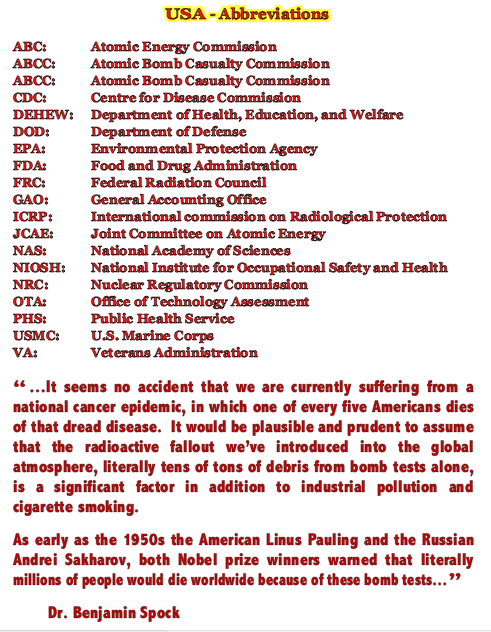
Monsanto was a leading producer of Agent Orange during the Vietnam war.
Its war contributions, began with its involvement in the Manhattan
Project and the creation of the atomic bomb, help explain
how Monsanto has managed to secure such staunch
allegiance from the U.S. government.
http://www.whale.to/b/mullins8.html
Baruch built the most lavish estate in
South Carolina, ‘Hobcaw Barony’.
See also our post »⇒ Oak Ridge
⇒ Atomic Tests in Australia ⇐

